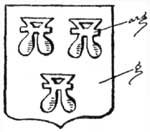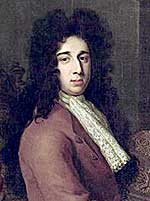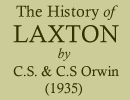
Roos heraldic crest.
John Roos died in 1458, and his son, Robert, enfeoffed Thomas Rotherham, Archbishop of York, of the Manor of Laxton. The Archbishop was then founding a new college, the Jesus College at Rotherham, and he appropriated 'The Church of Laxton, the collation and patronage of which belongs to me in right of my lay fee, to the College, as the benefice is rich enough to allow this'. This meant that the living and rectorial tithes went to the College, who had to see that the parish was served by a suitable vicar. But when the Archbishop died, in 1500, he directed in his will that if his niece, Ann Restwold, should marry Humphrey Roos, they were to have the Manor of Laxton, as the old entail was the inheritance of the Roos family. There was a Chancery suit about this, and in 1508 Humphrey and Ann got a licence to be enfeoffed of the Manor of Laxton.
The succeeding members of the Roos family who held Laxton during the sixteenth century, Humphrey, who died in 1531, William, and Francis, seem to have been peaceful and prosperous country squires, and it was one of them, probably, who built the manor house in front of the site of the old Norman castle which had fallen into decay after the Everingham family died out and the later lords no longer lived there. But Francis's son, Peter, who succeeded in 1578, got into financial difficulties. He executed several deeds of mortgage on his property and left many debts behind him. He had three children, a daughter, Anne, who married Sir Griffin Markham, and two boys, Gilbert and Peter.
Sir Griffin Markham, though his connexion with Laxton was slight, was an interesting Elizabethan. He was of Ollerton and served under Essex in France, where he was knighted for gallantry at the siege of Rouen. He wrote books on war, and his brother, Gervase Markham, wrote books on agriculture. But Sir Griffin, later, was mixed up with the Bye Plot against King James I, and he was convicted and condemned to death, only to be reprieved on the scaffold. His estates were confiscated and he was banished. His wife stayed in England, and lived for a time in the Rectory House at Laxton. In 1618 she committed bigamy with one of her servants, and '... did penance in a white sheet at Paul's Cross, for marrying one of her servants, her husband being alive; she will have to do the same elsewhere, and was fined £1000'.
Peter Roos died in 1605, when his son, Gilbert, was only 13. Gilbert was the last of the descendants of Geoffrey Alselin to hold the manor of Laxton and he had a strange and tragic career. A ward of the Crown, the King gave the custody of him to Lord Bruce, who farmed it out to one Richard Orrell, a comfit-maker in London. As soon as Gilbert came of age, he instituted Chancery proceedings against Orrell for the recovery of his inheritance. From the evidence in this case it appears that Orrell had married Gilbert, at the age of 15, to his daughter Elizabeth. Gilbert said he had trusted Orrell and let him have the keys of his chest containing the evidence of his inheritance. One Ralfe Benet, who was a servant of Gilbert's father, said that Orrell used to come down to Laxton and made a great show of looking after the property, but that Benet, who kept the Court Roll and held the Manor Court, had never been paid during Gilbert's minority. The case was further complicated by Gilbert's cousin, Robert Roos, claiming certain lands in Laxton, of which Orrell had allowed him to take possession. So, when Gilbert entered into his inheritance he was heavily encumbered with the expenses of the Chancery suit, and the debts of his father and his sister, and he had to take out further mortgages on the property. His difficulties were too much for him, and in 1618 he sold all his property in Laxton and Kneesall to George Villiers, then Marquis of Buckingham, the favourite of James I, for £6,000, and he died shortly after, being about the age of 28 years. With him ended the long line of Laxton lords founded shortly after the Norman Conquest by Geoffrey Alselin. But the family of Roos has continued in Laxton through other branches, the name modified to Rose, up to the present day.
The Duke of Buckingham did not keep the estate long, but sold it, in 1625, to Sir William Courten, Knight. Sir William is an interesting figure and typical of a new class in England at that time. He was the son of a Flemish refugee, from Menin, who had settled in London and traded in silk and linen. William went as a young man to Haarlem, on business, and there married the deaf and dumb daughter of a wealthy Dutch merchant, with a dowry of £60,000. In 1606 he entered into a partnership with his brother, and their business prospered exceedingly, in spite of a fine of £20,000 inflicted on them by the Court of the Starchamber for exporting gold, in 1619. He lent large sums both to James I and Charles I, and it seems possible that his purchase of Laxton from Buckingham may have been in settlement of a debt owing to him by the latter. He had a fleet of 20 ships trading with Africa and the West Indies, and 5,000 sailors, and in 1627 he was given letters patent to colonize some of the West Indian Islands. He sent out 1,850 people to Barbados, but his colonists were forcibly expelled by the Earl of Carlisle in 1629. He invested largely in land in England, chiefly in Northamptonshire, and was knighted, but he never recovered the money he had lent to the King. His children all married well, his three daughters respectively marrying the Earl of Kent, Sir Edward Litdeton, and Richard Knightley, Esq., of Northamptonshire, and his son, William, a daughter of the Earl of Bridgwater. He died in 1636. His Laxton property he regarded, probably, as an investment rather than as an amenity, for he never lived there. The manor house was occupied by his Steward, Mr. Samuel Stanford, and a very complete and beautiful terrier and map of Laxton and Kneesall, still in perfect preservation, were made under his instructions.
His son, William Courten, lost most of the money made by his father and went bankrupt in 1643, but before this, in 1640, he had sold Laxton and Kneesall to Robert Pierrepoint, Earl of Kingston, a member of a great and ancient Nottinghamshire family.
The Pierrepoint family, with whom Laxton has remained until the present day, had come to England with William the Conqueror and had been settled in Nottinghamshire for several centuries. Sir Robert de Pierrepoint fought at Bannockburn and was a colleague of Sir Adam de Everingham as a Commissioner of Array for the county, in 1333.
The purchaser of Laxton was known as 'The Good Earl of Kingston'. At the outbreak of the Civil War, he, like many other moderate men, found his sympathies deeply divided, and for some time he tried to remain neutral, saying: 'When I take arms with the King against Parliament, or with the Parliament against the King, let a cannon-ball divide me between them.' But eventually he joined the King and, in 1643, he was taken prisoner near Gainsborough and dispatched in a boat towards Hull. But a Royalist battery on shore opened fire on the boat, and the Earl was struck by a cannon-ball which divided his body in half, thus fulfilling his premonition. The history of the good Earl and his sons is a striking example of the division of families caused by the Civil War. The Earl was neutral and did not want to support either side against the other. His eldest son, Henry, the second Earl, was primarily a student, but he joined the King and was with him during the siege of Oxford. After the Restoration, he was a member of Charles II's Privy Council. The second son, William, known as 'Wise William', sat in the Long Parliament and was an intimate friend of Cromwell, who stayed with him at Thoresby. He fought for the Parliament but was always moderate in his views and withdrew from politics before the trial of the King. In 1660 he sat in the Short Parliament which restored Charles II, so his land was not confiscated at the Restoration, as was that of most prominent Parliamentarians.

Evelyn, 5th Duke of Kingston (c.1655-1726).
The fifth Earl, Evelyn, was created Duke of Kingston in 1715. He was a prominent Whig, Lord President of the Council, a leader of the fashionable world, and father of a brilliant daughter, the Lady Mary Wortley Montagu. His grandson, the second Duke, who succeeded as a minor in 1726, raised a regiment of horse against the Young Pretender in the '45. On his death, in 1773, the dukedom lapsed. But in 1806, his cousin and heir, Charles, Viscount Newark, was created Earl Manvers, reviving a name introduced into the family in 1297, and the present holder of the title is the fifth of this creation.
